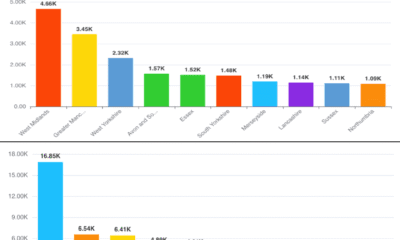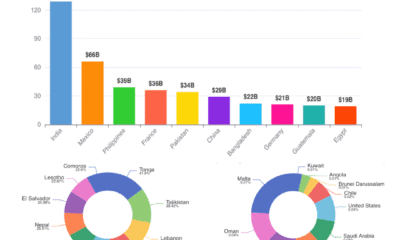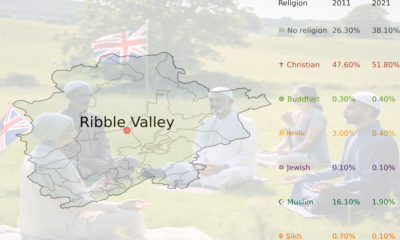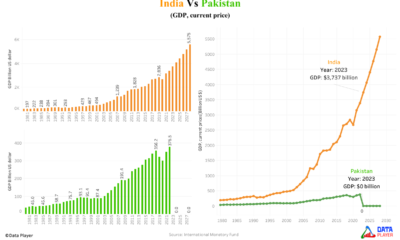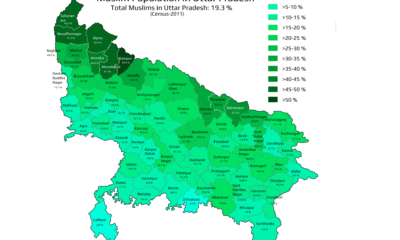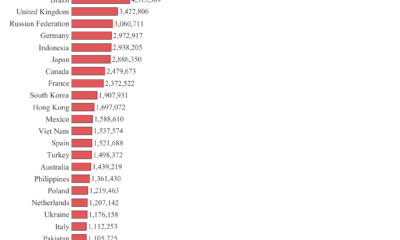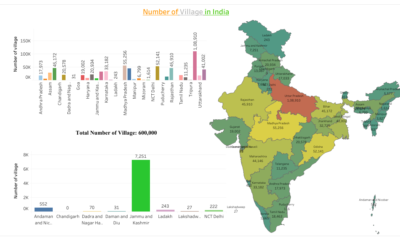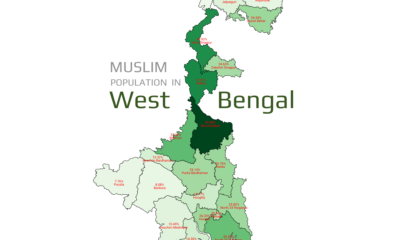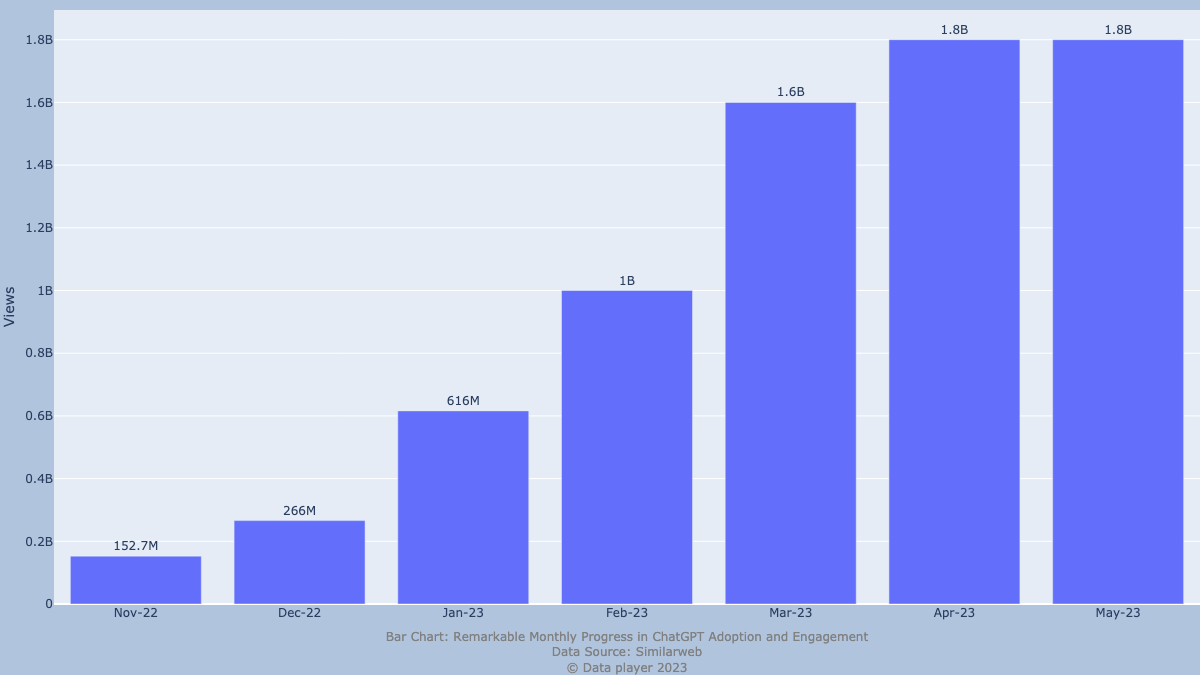

Technology
Remarkable Monthly Progress in ChatGPT Adoption and Engagement
Published
2 years agoon
Introduction
In today’s tech-savvy world, ChatGPT has become a go-to choice for chatting with computers. It can understand and respond to our questions just like we’re having a conversation with a real person. ChatGPT’s popularity has skyrocketed, and in this, we’ll explore the incredible increment in monthly views from November 2022 to May 2023. It’s amazing to see how more and more people are relying on ChatGPT all around the globe.
Analysis of the above bar chart
- November 2022: The viewership of ChatGPT started with a substantial count of 152.7 million views, indicating a positive reception from users during its initial launch.
- December 2022: The views experienced a significant surge, reaching 266 million, suggesting an increase in user interest and engagement.
- January 2023: ChatGPT continued to gain momentum, with views soaring to 616 million, reflecting a growing user base and heightened curiosity.
- February 2023: The viewership crossed the billion mark, reaching a staggering 1 billion views. This milestone signifies ChatGPT’s widespread adoption and popularity among users.
- March 2023: The popularity of ChatGPT continued to soar, with views reaching an impressive 1.6 billion. The substantial growth indicates sustained interest and engagement from users.
- April 2023: The viewership witnessed further growth, surpassing the 1.8 billion mark. This milestone reflects a sustained and expanding user base, solidifying ChatGPT’s position as a prominent conversational AI platform.
- May 2023: The viewership remained consistently high at 1.8 billion views, maintaining the strong user engagement and interest observed in the previous month.
The monthly views of ChatGPT exhibited consistent growth and an upward trend throughout the analyzed period and it can be clearly seen by above line chart. The exponential increase in viewership from November 2022 to May 2023 showcases the rapid adoption and acceptance of ChatGPT among users. The consecutive months of high viewership indicate a sustained interest in and reliance on ChatGPT as a valuable conversational AI tool.
Why People are engaging more with ChatGPT every month
- More and more people are learning about ChatGPT and realizing how useful it can be for various tasks. As awareness spreads, more individuals and businesses are using ChatGPT, which leads to higher viewership.
- Over time, ChatGPT has been getting better at what it does. It has become more accurate and effective, which makes people trust and use it more, resulting in increased viewership.
- When people have a good experience with ChatGPT, they tend to tell others about it. Positive reviews and recommendations help spread the word, and as a result, more people start using ChatGPT, contributing to its growing viewership.
- ChatGPT is versatile and can be used in various industries and sectors. This wide applicability attracts users from different fields, leading to increased viewership as more people find value in utilizing ChatGPT for their specific needs.
- The technology behind ChatGPT, called natural language processing and machine learning, keeps improving. These advancements make ChatGPT more efficient and accurate, making it even more appealing to users and resulting in a rise in viewership.
- The developers of ChatGPT continuously update and improve the system. They fix bugs and provide technical support, which builds trust and confidence in the platform. Users appreciate the ongoing support, making them more likely to use ChatGPT and contribute to its growing viewership.
Conclusion
The monthly viewership data highlights the impressive growth and popularity of ChatGPT within a short span of time. The exponential increase in views from November 2022 to May 2023 signifies the successful integration of ChatGPT into various applications and industries, as well as its increasing importance in meeting the conversational needs of users worldwide.
As ChatGPT continues to evolve and adapt to user requirements, its viewership is expected to experience further growth and reach new milestones in the future.
You may like


Knife Crime in England and Wales: A Deepening Danger We Can’t Ignore


Top Remittance-Receiving Countries in the World


Religious Demographics of Ribble Valley, Lancashire, United Kingdom


Religious Demographics of Pendle, Lancashire, England, United Kingdom


Religious Demographics of Lancaster, Lancashire, England, United Kingdom


Religious Demographics of Pendle, Lancashire, United Kingdom
Technology
Top Most-Visited Websites 2025 | What the World Was Searching?
Published
2 months agoon
July 28, 2025Excerpt: The latest June 2025 web traffic rankings reveal a clear dominance by U.S.-based tech giants, with Google’s services leading the pack. This analysis delves into the top 50 most-visited websites, highlights sector trends—especially the rise of adult content platforms—and offers comprehensive data insights through tables and charts.
Global Leaders in Online Traffic
Google Search retains its crown as the world’s most-visited site, followed closely by YouTube and Facebook. U.S. companies occupy eight of the top ten slots, underscoring their global reach and infrastructure advantages.
- Search Engines: Google.com (1st), Bing.com (23rd), DuckDuckGo.com (43rd)[1]
- Social Media: Facebook.com (3rd), Instagram.com (4th), X.com/Twitter.com (6th)[2]
- Video Platforms: YouTube.com (2nd), Twitch.tv (29th), Bilibili.com (25th)
Top Most-Visited Websites (June 2025)
Sector Breakdown
Analyzing the full data set of the top 50 sites reveals distribution across categories. Notably, adult content sites have climbed into prominence, reflecting changing consumption patterns.
Rise of Adult Content Platforms
Adult websites now account for six of the top 50, including Pornhub (17th), XVideos (27th), xHamster (30th), XNXX (41st), Eporner (49th), and Stripchat (45th). These platforms collectively draw hundreds of millions of daily visits, fueled by mobile accessibility and global bandwidth improvements.
- Regional Insights: Europe and North America remain the largest audiences, but Asia-Pacific shows the fastest growth.
- Regulatory Impact: Varying national regulations affect rankings; for instance, China’s restrictions elevate domestic sites like Bilibili (25th).
Complete Data Sets and Methodology
Our analysis leverages the complete data sets provided by Similarweb and Semrush for June 2025. Metrics include unique visitors, engagement time, and traffic sources. Combining both platforms ensures accuracy and cross-validation.
Regional Variations and Growth Prospects
Outside the U.S., Japan’s Yahoo.co.jp (10th) and China’s ByteDance-owned TikTok.com (13th) demonstrate regional dominance. Emerging markets in Latin America and Africa are increasingly represented by news portals (e.g., Globo.com at 37th) and e‑commerce (eBay.com at 47th).
- Latin America: MercadoLibre’s influence is rising, though not yet in the top 50.
- Africa: Upticks in local news and messaging apps signal future entries.
Key Takeaways
- U.S. Tech Supremacy: American companies maintain a stronghold on global web traffic.
- Adult Content Emergence: Six adult sites in the top 50 reflect shifting consumer behaviors and improved accessibility.
- Diverse Growth: News, marketplace, and software categories continue expanding regionally.
As internet usage evolves, these rankings will adjust, highlighting the importance of continuous monitoring of complete data sets for market insights and strategic decision-making.
References
- Similarweb.com. (2025). June 2025 Global Ranking. Available at: https://similarweb.com/global-june2025 [Accessed 24 Jul. 2025].
- Semrush.com. (2025). Website Analytics Report June 2025. Available at: https://semrush.com/reports/june2025 [Accessed 25 Jul. 2025].
Technology
These Are the 20 Most Hacked Passwords of 2024 – Are You Using One?
Published
2 months agoon
July 27, 2025Excerpt: Despite ongoing warnings about password hygiene, the latest NordPass analysis reveals that users persistently opt for shockingly weak credentials. Our deep dive into the Top 20 most common passwords uncovers alarming patterns and underscores the urgent need for stronger, individualized security measures.
Overview of the Top 20 Passwords
The NordPass dataset highlights which passwords are most prevalent globally, revealing that all 20 entries can be cracked in under one second. The concentration of simple numeric sequences dominates the list, reflecting a troubling reliance on easily guessable strings [3]
Top 20 Most Common Passwords (2025) – Time to Crack & Estimated Count
Key Insights from the Data
- Uniformly Fast Crack Times: Every password in the list takes less than one second to breach using standard brute-force tools.
- Numeric Dominance: Half of the top 20 are strictly number-based, underscoring the false sense of security users place in simple digit strings.
- Minimal Variations: Common patterns like “qwerty” and repeated digits appear repeatedly, showing a lack of creativity in user-generated passwords.
- Complete Data Sets: The NordPass report provides full visibility into all 20 passwords, enabling comprehensive analysis and targeted user education.
- Facts: About 78% of the most common passwords globally (including those in the US list) can be cracked in under 1 second.
Distribution of Password Popularity
Examining the estimated counts across the top 10 entries illustrates how a handful of passwords account for the majority of exposures. The following bar chart depicts the gradient from the most to the least common within this subset [4]
Categorical Breakdown of Password Types
To better understand user behavior, passwords can be grouped by composition. The chart below shows the proportion of numeric-only, alphabetic, keyboard-pattern, and mixed/phrase entries among the top 20.
Regional and Security Implications
While NordPass’s global dataset provides a broad overview, regional analyses often mirror these trends, with the majority of users favoring brevity and familiarity over complexity. Cybersecurity experts warn that such predictable selections dramatically increase vulnerability to credential-stuffing attacks, particularly as automated tools improve in speed and sophistication.
- Awareness Campaigns: Educating users on the dangers of reuse and encouraging passphrases can mitigate risk.
- Multi-Factor Authentication: Implementing additional verification steps adds a critical layer of defense.
- Password Managers: Leveraging tools that generate and store unique passwords reduces human error.
A strong password is your first line of defense against hackers. According to NordPass’s 2024 report, millions of people still use weak passwords like “123456”, “password”, and “123456789”—all of which can be cracked in less than one second using automated tools. Shockingly, over 3 million accounts used “123456” alone. These passwords offer no real protection and are often the first combinations tested in cyberattacks.
NordPass Most Common Passwords by Country (2024)
- United States: The most common password is secret, used by over 328,000 people. While unique compared to global trends, it remains easily crackable in under 1 second.
- India: 123456 is the top choice with 363,000+ estimated uses. Its simplicity makes it highly vulnerable, cracked instantly despite India’s large digital population.
- United Kingdom: qwerty123 dominates with ~300,000 estimated uses. Though slightly more complex than 123456, it is still cracked in less than 1 second.
- Canada, Netherlands, Finland, Norway, and Lithuania also share qwerty123 as the top password, with combined usage exceeding 1.25 million. This cross-country trend suggests a regional reliance on keyboard-patterned passwords.
- Spain, Italy, Brazil, Argentina, Mexico, South Africa, and New Zealand all have 123456 as the most used password, with combined usage exceeding 1.9 million. This reflects a global reliance on ultra-simple numeric patterns.
- Germany’s top password passwort (the German word for “password”) is used by ~275,000 users, reflecting a language-based but still weak approach.
- France favors doudou (a term of endearment), indicating cultural personalization, but it’s still cracked instantly.
- Russia’s 1q2w3e and Poland’s zaq12wsx show regional keyboard patterns that offer marginal complexity but remain insecure.
- Ukraine stands out with PovlmLy727, appearing complex but still crackable instantly—likely due to predictable structure.
- Greece uses 212121 (repeating numbers), and Hungary uses long numeric strings like 63245009, both offering no real strength.
- Latvia, Estonia, and Denmark show attempts at mixing words and numbers (911yana777, D1lakiss, webhompass), though none survive even 1 second of cracking attempts.
- Iceland’s kassi (a common word) and Croatia’s dinamo (sports-related) reflect local vocabulary trends, but both lack complexity.
- Philippines has admin as its top password, a known default login credential—an alarming sign for personal and organizational security.
- Australia continues to use password, one of the oldest and weakest choices in password history, used by ~280,000 people.
- Over 90% of the top 200 passwords used in each country can be cracked in less than 1 second, showing widespread reliance on weak credentials.
- The United States has the longest maximum crack time at approximately 2 hours 20 minutes, with complex examples like P@ssw0rd!2023.
- The United Kingdom and Canada follow with maximum crack times exceeding 1 hour, indicating slightly stronger password habits.
- India’s longest crack time among its top 200 passwords is around 20 minutes, with examples like india@2023 and bharat#123. However, most Indian users still rely on simple numeric strings like 123456.
- Countries with the shortest maximum crack times include Croatia and the Philippines, where even the strongest common passwords are cracked in just 5 minutes.
- Stronger passwords typically include a mix of uppercase and lowercase letters, numbers, and special characters.
- Despite the presence of stronger passwords, the vast majority of users globally continue to use extremely weak ones, making accounts highly vulnerable.
- There is an urgent global need for better password practices, adoption of password managers, and the use of multi-factor authentication (MFA).
- Similarweb.com. (2025). June 2025 Global Ranking. Available at: https://similarweb.com/global-june2025 [Accessed 24 Jul. 2025].
- Semrush.com. (2025). Website Analytics Report June 2025. Available at: https://semrush.com/reports/june2025 [Accessed 25 Jul. 2025].
- NordPass.com. (2025). Top 20 Most Common Passwords. [online] Available at: https://nordpass.com/most-common-passwords/ [Accessed 21 Jul. 2025].
- TechRepublic.com. (2025). How Fast Hackers Crack Your Passwords. [online] Available at: https://www.techrepublic.com/article/password-cracking-speeds/ [Accessed 23 Jul. 2025].
Countries & Maximum Crack Time Observed in Their Top 200 Passwords (NordPass 2024)
How to protect your password from hackers
To protect yourself, use a password that is at least 12 characters long, with a mix of uppercase and lowercase letters, numbers, and special symbols. For example, a password like “T!mberWolf_92@Safe” would take over 1 trillion years to crack using current brute-force methods. Even better, use a passphrase—a string of unrelated words and symbols like “Sun$Track_Lion94”—which is easier to remember and harder to guess.
Also, always enable two-factor authentication (2FA) to add another layer of security. Never reuse passwords across accounts. Instead, use a password manager to create and store unique, complex passwords for each site.In summary, by avoiding predictable passwords and following simple best practices, you can make your password virtually uncrackable—even by the most advanced hackers.
Conclusion
The persistence of easily compromised passwords in NordPass’s complete data set highlights an ongoing challenge for both individuals and organizations. Adopting robust password policies, combined with user-friendly security tools, is essential to counteract the allure of convenience-based but dangerously weak credentials.
References
Technology
The Brains Behind AI: A Look at the World’s Top Supercomputers
Published
2 months agoon
July 24, 2025The Brains Behind AI: A Look at the World’s Top Supercomputers
AI is changing the world quickly! Powerful computers called supercomputers are needed to train the AI models that power things like chatbots and self-driving cars. Let’s see which supercomputers are the most powerful right now.
| Rank | Name | Company | H100 Equivalents |
|---|---|---|---|
| 1 | Colossus Memphis Phase 2 | xAI | 200,000 |
| 2 | Meta 100k | Meta AI | 100,000 |
| 3 | OpenAI/Microsoft Goodyear Arizona | Microsoft/OpenAI | 100000 |
| 4 | xAI Colossus Memphis Phase 1 | xAI | 100000 |
| 5 | Oracle OCI Supercluster H200s | Oracle | 65536 |
xAI’s Colossus Memphis Phase 2 is the champ! It has 200,000 special computer chips called H100 equivalents. This means it’s really, really fast! It can train a big AI model in just a short time. Other companies are building powerful supercomputers too, but some big players like Google and Amazon aren’t sharing as much information about their supercomputers.

Muslim Population in Goa (2025 Update): District-Wise Data, Percentage & Analysis

Muslim Population in Telangana (2025 Update): District-Wise Data, Percentage & Analysis

Muslim Population in Karnataka (2025 Update): District-Wise Data, Percentage & Analysis

Trump’s 2025 Tariffs on India Explained: Full List, Dates, Products, and 50% Duty Impact

Muslim Population in Odisha (2025 Update): District-Wise Data, Percentage & Analysis

Muslim Population in Goa (2025 Update): District-Wise Data, Percentage & Analysis

Muslim Population in Telangana (2025 Update): District-Wise Data, Percentage & Analysis

Muslim Population in Karnataka (2025 Update): District-Wise Data, Percentage & Analysis
Trending

 Economy2 years ago
Economy2 years agoWhy Pakistan’s economy is drowning while India’s economy is touching the sky

 Religion1 year ago
Religion1 year agoMapped: What are the muslims population in Uttar Pradesh | State of India

 Technology2 years ago
Technology2 years agoHighest number of software developers by country in the world 2023 by GitHub | Data Player

 Demographics1 year ago
Demographics1 year agoMapped: Average Working Hours by European Countries in 2024

 Demographics2 years ago
Demographics2 years agoWhat are the Number of Villages in India by its State and Union Territory

 Superpower countries1 year ago
Superpower countries1 year agoGlobal Nuclear Warhead Distribution by Nation 2024

 Demographics2 years ago
Demographics2 years agoMassive population size by Indian states 2023

 Religion1 year ago
Religion1 year agoMapped: What is Muslim Population in West Bengal by District wise 2011
